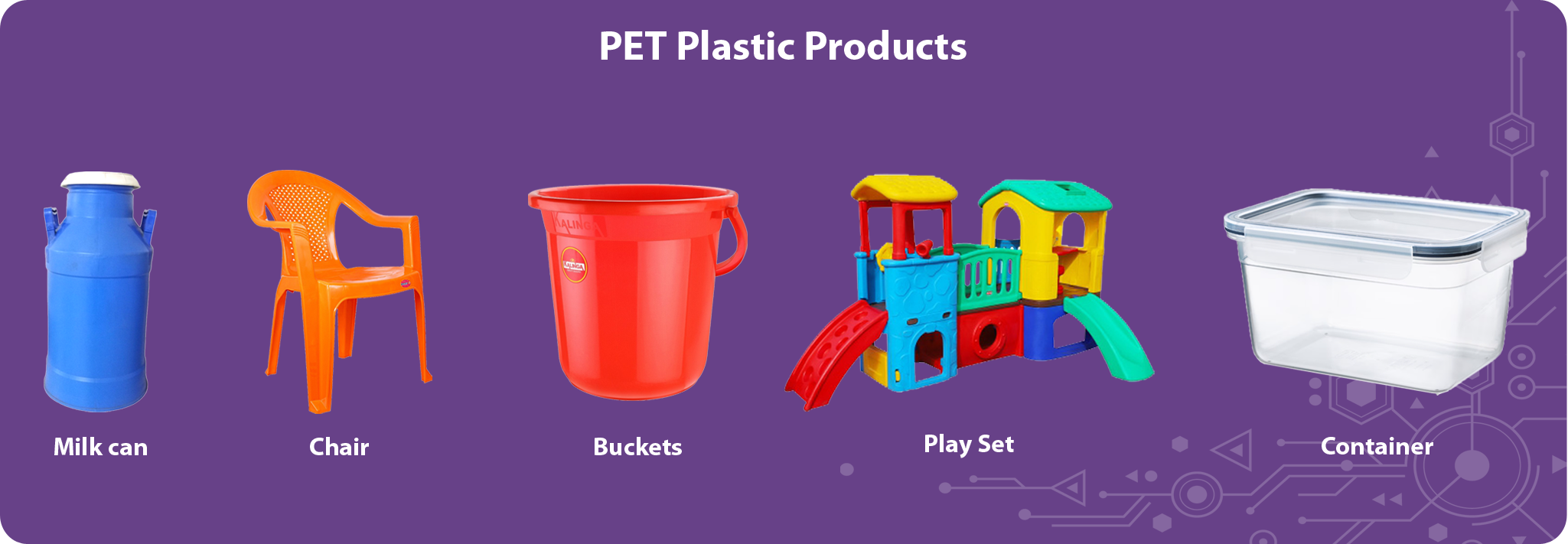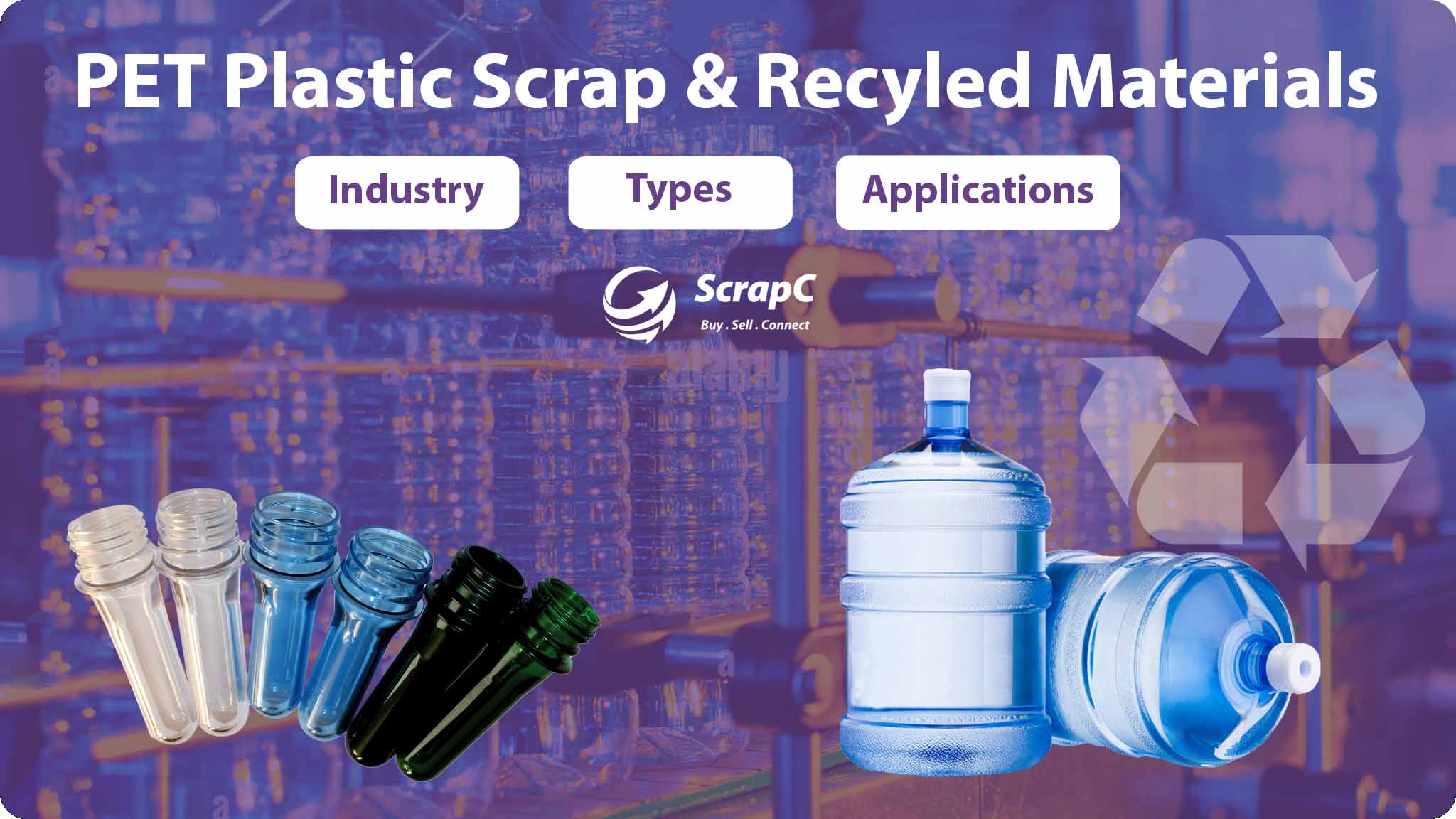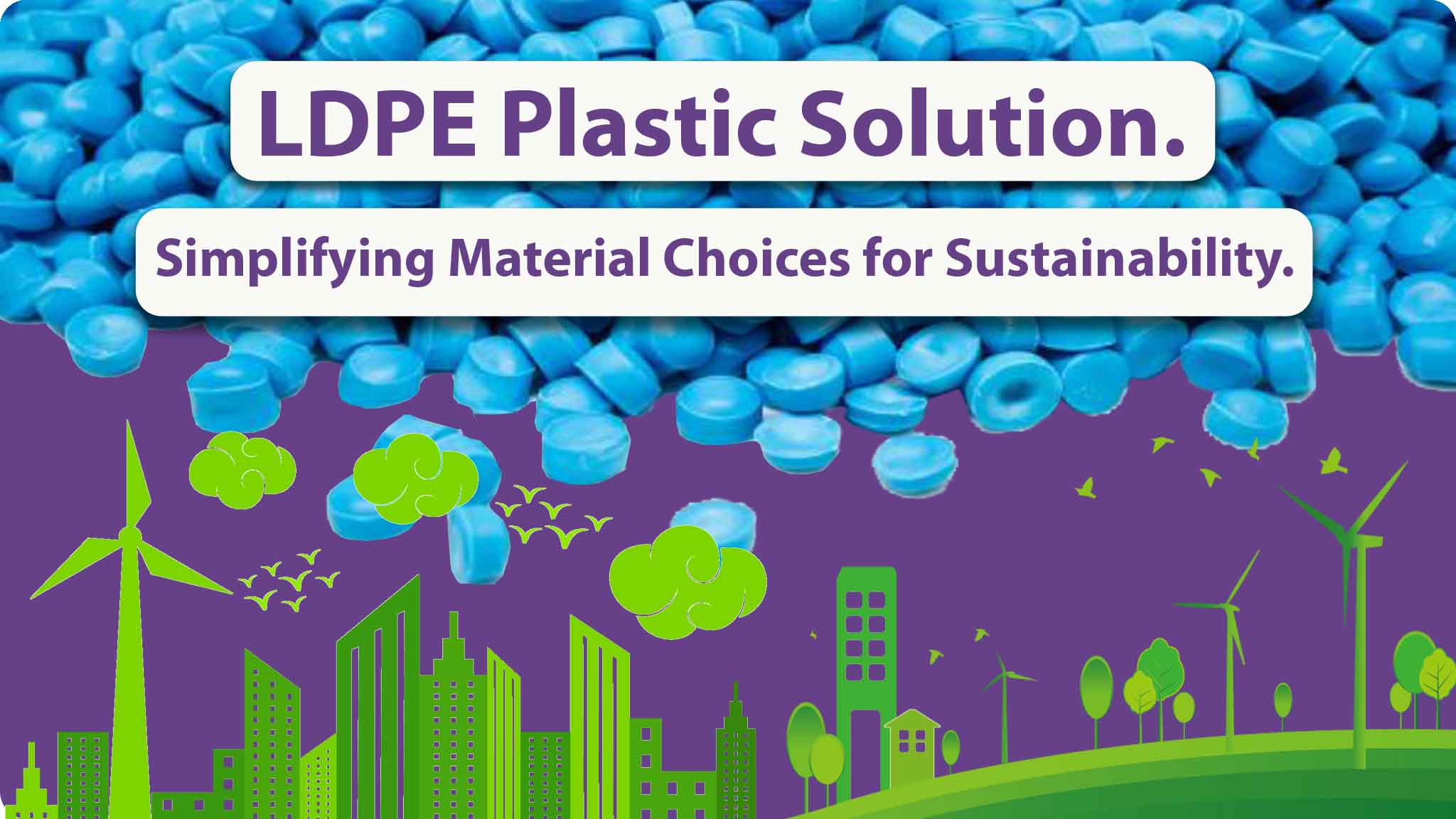Exploration of PET Plastic Scrap and Recycled Materials : Industries, Types and Uses
Introduction:
In the modern world, plastic has become an integral part of our daily lives, providing convenience and ease. Among the various types of plastics, polyethylene terephthalate (PET) is one of the most widely used materials, especially in the packaging industry. However, with increasing environmental concerns, efforts are being made to reuse and recycle PET plastic scrap. For extensive research, we’ll delve deeper into the diverse world of PET plastic scrap, highlighting its different types, properties, and important roles in industries.

Types of PET Plastic Scrap:
PET bottle scrap:
PET bottle scrap is a ubiquitous form of discarded PET plastic, typically originating from soft drink containers. Once dried, the sludge becomes a valuable resource in the recycling chain. The textile and fiber industry makes extensive use of PET bottle scrap in the production of polyester fibers and fabrics, providing a sustainable alternative to virgin material.
PET bale:
PET lumps refer to large pieces or pieces of PET plastic that may result from the manufacturing process or product use. These fragments can be recycled into a variety of plastic products, including containers, ensuring that the lifecycle of PET can be extended beyond its initial use.
PET Roll:
PET plastic in roll form is used to make labels, tapes and flexible packaging. The printing and packaging industry relies on PET rollers to create labels with high-quality graphics and flexible packaging solutions. The octahedral nature of PET rolls makes them indispensable for providing attractive and functional packaging.
PET Clear Grind:
Clear regrind refers to transparent PET plastic that has been ground for recycling. The same material is commonly used in the production of clear plastic products including bottles and containers. Clear Regrind not only contributes to environmental sustainability but also maintains the visual appeal of transparent plastic items.
PET Scrap:
The term “PET scrap” is a broad classification encompassing various types of discarded PET plastics, reflecting the diverse range of products and applications that can be obtained from them. Industries such as construction involve PET scrap in the manufacturing of carpet, strapping, and non-food containers, demonstrating the versatility of recycled PET materials.
Gummed Company PET Film:
PET films with gummed backing are used in the printing and labeling industries. The adhesive properties of the adhesive surface make it ideal for labels and stickers. PET Plastic Scraper combines eco-friendliness with functionality keeping in mind the need for a sustainable solution in the frequency labeling sector.
Landfill PET Scrap:
Belted PET scrap involves compressing PET scrap and collecting it into self-contained bales. Or the processing method increases the efficiency of handling and transportation. Recycling facilities and manufacturing plants often prefer safe PET scrap due to the efficiency of the process, making recycling easier.
PET Sheet:
PET sheet, characterized by its flat and thin structure, is used in various industries. Common applications include packaging materials, blister packs and signs. The lightweight and durable nature of PET sheets makes them the preferred choice in various sectors, significantly reducing steam costs of traditional plastics.
Captain Tape:
Kapton tape made from PET is known for its high temperature resistance. Industries such as aerospace and electronics take advantage of Kapton tape for insulation and protection in high-temperature environments. This underlines the important role of PET plastic scrapers in creating materials that meet stringent performance requirements.
Natural PET Granules:
Natural PET particles represent the pigmented nature of PET plastic. This type of PET material is used in the manufacturing of clear plastic products where color uniformity is required. The absence of added dyes in natural PET granules makes them suitable for applications such as clear bottles and containers.
PET bottle transparent:
Transparent PET bottles, which are commonly used for packaging various liquids, play an important role in the beverage industry. The transparency of PET bottles allows consumers to visually evaluate the contents, contributing to their popularity. The beverage industry, including water, soft drinks and other soft drinks, relies heavily on the transparency of PET bottles for product visibility and consumer appeal.
Demand and Supply Challenges:
As the demand for recycled PET plastic scrap continues to increase, the industry faces several challenges to ensure a sustainable supply chain:
Pollution problem:
Contamination of PET scrap with other materials has become a major obstacle. The presence of non-PET materials can compromise the quality of the recycled product, making it challenging to meet industry standards.
Collection and Classification Challenges:
Inefficient collection and sorting processes contribute to the challenge of obtaining high-quality PET scrap. Improving the overall quality of recycled PET materials requires improved collection and sorting infrastructure.
Lack of Awareness:
Limited awareness among consumers and businesses about the importance of recycling PET plastics hinders effective collection. Punishment campaigns and initiatives are important to address this issue and encourage responsible disposal of plastics.
Global Market Fluctuations:
The recycling industry is not immune to global market fluctuations. Changes in raw material prices and market dynamics can affect the profitability of recycling operations, thereby affecting the overall stability of the PET plastic scrap market.
Depending on the industry:
Building trust in the PET plastic scrap industry is essential to promote sustainable practices and ensure the success of recycling initiatives. Key aspects to consider in establishing and maintaining trust include:
Transparent supply chain practices:
Establishing trust among stakeholders requires implementing transparent supply chain practices. Clear documentation and visibility into the recycling process reassures consumers and businesses about the legitimacy of recycling PET products.
Certification of Recycled Materials:
Achieving certification for recycled PET materials increases credibility in the industry. Certifications from recognized organisations guarantee the quality and environmental sustainability of recycled PET products.
Stakeholder Collaboration:
Collaboration between stakeholders, including recyclers, manufacturers and policy makers, is key to tackling the challenges together. Common goals and concerted efforts contribute to the overall success of recycling initiatives.
Connecting buyers and sellers on our platform
At ScrapC Marketplace, we understand the importance of fostering a sustainable PET plastic recycling ecosystem. To facilitate buying and selling of PET plastic scrap, we have developed a user-friendly platform. Whether you are looking to buy high quality recycled PET material or looking for a market for your PET plastic scrap, our platform provides a seamless solution.
Buyers can easily find a wide range of PET plastic scrap types, ensuring a reliable source of recycled material for a variety of applications. Similarly, Sellers can display their PET plastic scrap inventory, contributing to the circular economy by connecting with environmentally conscious buyers.
By using our platform, you contribute to the development of the PET plastic recycling industry by actively participating in a sustainable future. Join us in our commitment to make the recycling process easy, transparent and efficient.
Conclusion:
As industries around the world shift towards sustainable practices, the demand for recycled PET plastic scrap is likely to increase significantly. Understanding the different categories, characteristics and uses of PET plastic scrap is essential to promoting a circular economy and reducing the environmental impacts associated with plastic waste.. To ensure a stable and reliable source of high-quality recycled PET material, it is important to address supply chain challenges from collection to processing.
By building trust in the industry through transparent practices, certifications and collaborative efforts, stakeholders can work together to overcome current challenges. This concrete approach is critical to shaping a more sustainable and eco-friendly future where PET plastic plays a key role in reducing the environmental footprint of scrap plastic use. As we unravel the complexities of PET plastic recycling, the journey towards a circular economy becomes not only a necessity but also a shared responsibility for a green planet.





